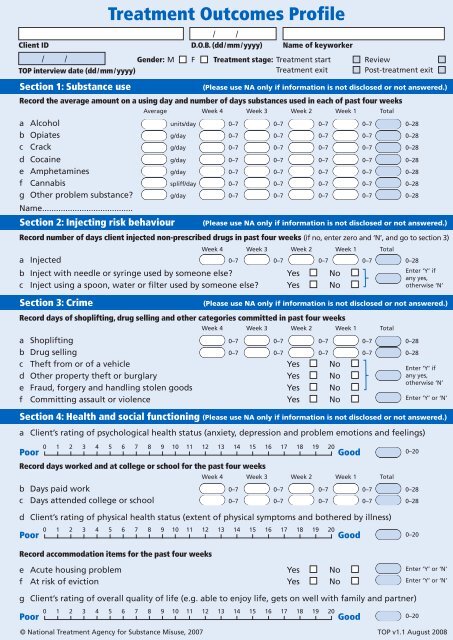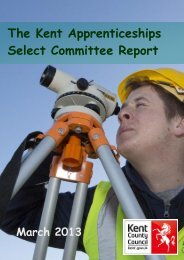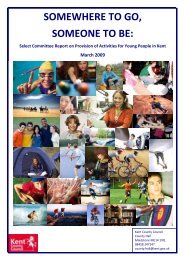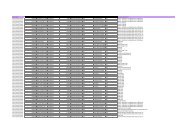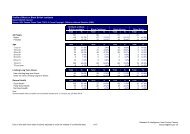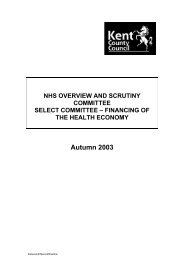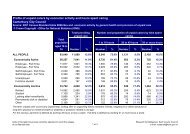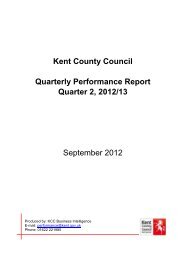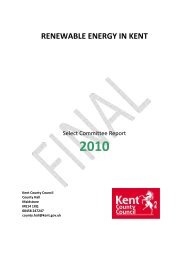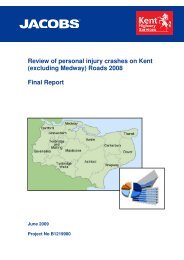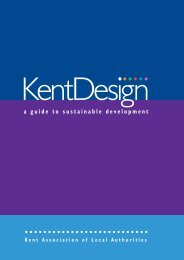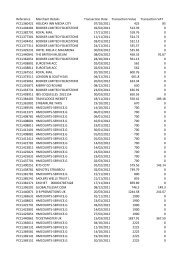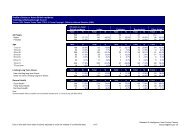TOP form - National Treatment Agency for Substance Misuse
TOP form - National Treatment Agency for Substance Misuse
TOP form - National Treatment Agency for Substance Misuse
Create successful ePaper yourself
Turn your PDF publications into a flip-book with our unique Google optimized e-Paper software.
Client ID<br />
Section 1: <strong>Substance</strong> use<br />
Record the average amount on a using day and number of days substances used in each of past four weeks<br />
Average Week 4 Week 3 Week 2 Week 1 Total<br />
a Alcohol units/day 0–7 0–7 0–7 0–7 0–28<br />
b Opiates g/day 0–7 0–7 0–7 0–7 0–28<br />
c Crack g/day 0–7 0–7 0–7 0–7 0–28<br />
d Cocaine g/day 0–7 0–7 0–7 0–7 0–28<br />
e Amphetamines g/day 0–7 0–7 0–7 0–7 0–28<br />
f Cannabis spliff/day 0–7 0–7 0–7 0–7 0–28<br />
g Other problem substance? g/day 0–7 0–7 0–7 0–7 0–28<br />
Name.......................................<br />
Section 2: Injecting risk behaviour<br />
Record number of days client injected non-prescribed drugs in past four weeks (if no, enter zero and ‘N’, and go to section 3)<br />
Week 4 Week 3 Week 2 Week 1 Total<br />
a Injected 0–7 0–7 0–7 0–7 0–28<br />
b Inject with needle or syringe used by someone else? Yes No<br />
c Inject using a spoon, water or filter used by someone else? Yes No<br />
Section 3: Crime<br />
<strong>Treatment</strong> Outcomes Profile<br />
/ /<br />
D.O.B. (dd/ mm / yyyy)<br />
Name of keyworker<br />
/ /<br />
Gender: M F <strong>Treatment</strong> stage: <strong>Treatment</strong> start Review<br />
<strong>TOP</strong> interview date (dd/ mm / yyyy)<br />
<strong>Treatment</strong> exit Post-treatment exit<br />
(Please use NA only if in<strong><strong>for</strong>m</strong>ation is not disclosed or not answered.)<br />
(Please use NA only if in<strong><strong>for</strong>m</strong>ation is not disclosed or not answered.)<br />
Record days of shoplifting, drug selling and other categories committed in past four weeks<br />
Week 4 Week 3 Week 2 Week 1 Total<br />
a Shoplifting 0–7 0–7 0–7 0–7 0–28<br />
b Drug selling 0–7 0–7 0–7 0–7 0–28<br />
c Theft from or of a vehicle Yes No<br />
d Other property theft or burglary Yes No<br />
e Fraud, <strong>for</strong>gery and handling stolen goods Yes No<br />
f Committing assault or violence Yes No<br />
Enter ‘Y’ if<br />
any yes,<br />
otherwise ‘N’<br />
(Please use NA only if in<strong><strong>for</strong>m</strong>ation is not disclosed or not answered.)<br />
Enter ‘Y’ if<br />
any yes,<br />
otherwise ‘N’<br />
Section 4: Health and social functioning (Please use NA only if in<strong><strong>for</strong>m</strong>ation is not disclosed or not answered.)<br />
a Client’s rating of psychological health status (anxiety, depression and problem emotions and feelings)<br />
Enter ‘Y’ or ‘N’<br />
Poor<br />
0 1 2 3 4 5 6 7 8 9 10 11 12 13 14 15 16 17 18 19 20<br />
Record days worked and at college or school <strong>for</strong> the past four weeks<br />
Good<br />
Week 4 Week 3 Week 2 Week 1 Total<br />
0–20<br />
b Days paid work 0–7 0–7 0–7 0–7 0–28<br />
c Days attended college or school 0–7 0–7 0–7 0–7 0–28<br />
d Client’s rating of physical health status (extent of physical symptoms and bothered by illness)<br />
Poor<br />
0 1 2 3 4 5 6 7 8 9 10 11 12 13 14 15 16 17 18 19 20<br />
Good<br />
0–20<br />
Record accommodation items <strong>for</strong> the past four weeks<br />
e Acute housing problem Yes No<br />
f At risk of eviction Yes No<br />
Enter ‘Y’ or ‘N’<br />
Enter ‘Y’ or ‘N’<br />
g Client’s rating of overall quality of life (e.g. able to enjoy life, gets on well with family and partner)<br />
Poor<br />
0 1 2 3 4 5 6 7 8 9 10 11 12 13 14 15 16 17 18 19 20<br />
Good<br />
0–20<br />
© <strong>National</strong> <strong>Treatment</strong> <strong>Agency</strong> <strong>for</strong> <strong>Substance</strong> <strong>Misuse</strong>, 2007 <strong>TOP</strong> v1.1 August 2008
<strong>Treatment</strong> Outcomes<br />
Profile (<strong>TOP</strong>)<br />
About the <strong>TOP</strong><br />
The <strong>Treatment</strong> Outcomes Profile (<strong>TOP</strong>) is a new drug treatment outcome monitoring tool that has been developed by the NTA<br />
in partnership with drug treatment providers in over 70 sites across England. It is applicable <strong>for</strong> use in all of the structured<br />
treatment modalities as defined by Models of Care <strong>for</strong> <strong>Treatment</strong> of Adult Drug <strong>Misuse</strong>rs: Update 2006. For the first time,<br />
service users, clinicians, service managers and commissioners will be able to obtain objective and comparable data about<br />
real improvements in service users’ lives that will be able to in<strong><strong>for</strong>m</strong> and improve practice on both an individual and strategic<br />
level.<br />
The <strong>TOP</strong> is a simple set of questions that will improve clinical practice by enhancing assessment and care plan reviews <strong>for</strong><br />
clients. The data it provides will improve per<strong><strong>for</strong>m</strong>ance monitoring. Data will be reported into the <strong>National</strong> Drug <strong>Treatment</strong><br />
Monitoring System (NDTMS) from October 2007 and results fed back to providers and commissioners from March 2008.<br />
There will also be monthly exception reports from NDTMS on non-returns and multiple submissions.<br />
The <strong>TOP</strong> should be completed within 2 weeks either side (+/-2 weeks) of the first modality start date at the beginning of each<br />
client’s treatment journey to record a baseline of behaviour in the month leading up to starting a new treatment journey. If the<br />
<strong>Treatment</strong> Start <strong>TOP</strong> is completed after the first modality start date, it should focus on the 28 days be<strong>for</strong>e this date. Review<br />
<strong>TOP</strong> scores should be recorded in regular 12-week review periods during treatment (it may be helpful to do this at the same<br />
time as a care plan review) to capture changes in behaviour. The first Review <strong>TOP</strong> can be completed 4 weeks or 29 days<br />
after the first modality start date. It should also be completed at <strong>Treatment</strong> Exit and may be used by some services to<br />
measure post <strong>Treatment</strong> Exit outcomes. Note: when services are introducing <strong>TOP</strong>, existing clients (as well as new<br />
presentations) should also have the <strong>TOP</strong> completed with them as part of the review process.<br />
How to complete the <strong>TOP</strong><br />
Start by entering:<br />
• Name and identifiers of your client (date of birth and gender)<br />
• Your name<br />
• Date of assessment<br />
• The stage at which the <strong>TOP</strong> is being completed – <strong>Treatment</strong> Start, Review, <strong>Treatment</strong> Exit, or post <strong>Treatment</strong> Exit.<br />
Types of responses:<br />
• Timeline – invite the client to recall the number of days in each of the past four weeks on which they did something – <strong>for</strong><br />
example, the number of days they used heroin. You then add these to create a total <strong>for</strong> the past four weeks in the blue<br />
NDTMS box<br />
• Yes and no – a simple tick <strong>for</strong> yes or no, then a “Y” or “N” in the blue NDTMS box<br />
• Rating scale – a 20-point scale from poor to good. Together with the client, mark the scale in an appropriate place and<br />
then write the equivalent score in the blue NDTMS box.<br />
You should aim to ask and complete every question. Do not leave any of the blue boxes blank. Enter “NA” if the<br />
client refuses to answer a question or, after prompting, cannot recall.<br />
(See <strong>TOP</strong> keyworker guidance and Interim revised guidance (August 2008) <strong>for</strong> more detailed in<strong><strong>for</strong>m</strong>ation:<br />
www.nta.nhs.uk/<strong>TOP</strong>)<br />
Alcohol units converter<br />
Drink %ABV Units<br />
Pint ordinary strength lager, beer or cider 3.5 2<br />
Pint strong lager, beer or cider 5 3<br />
440ml can ordinary strength lager 3.5 1.5<br />
440ml can strong lager, beer or cider 5 2<br />
440ml can super strength lager or cider 9 4<br />
1 litre bottle ordinary strength cider 5 5<br />
1 litre bottle strong cider 9 9<br />
Drink %ABV Units<br />
Glass of wine (175ml) 12 2<br />
Large glass of wine (250ml) 12 3<br />
Bottle of wine (750ml) 12 9<br />
Single measure of spirits (25ml) 40 1<br />
Bottle of spirits (750ml) 40 30<br />
275ml bottle alcopops 5 1.5<br />
Thank you <strong>for</strong> your contribution to the <strong>TOP</strong>


